Types and Roles of Topic Shift Markers in Non Face-to-Face Conversation in Thai
Main Article Content
Abstract
Objectives: This article aims to study types and roles of topic shift markers in non face-to-face conversation in Thai.
Methods: The data were collected from 30 telephone conversations and 200 LINE and Facebook Messenger conversations. It contains 230 conversations in total.
Results: The results reveal that there are 10 types of topic shift markers including 1) Cohesive markers, 2) Markers expressing sudden thought, 3) Markers of calling the other party, 4) Markers expressing emotions, 5) Markers of getting interlocutor’s attention, 6) Markers indicating topic, 7) Conclusion markers, 8) Markers of ending topic, 9) Markers indicating interrogation, and 10) Markers of invitation. These markers serve 8 roles, in topic shifting, that is 1) To indicate topic shift, 2) To link a new topic with the preceding or prior topic, 3) To express a sudden thought, 4) To attract the other party’s attention, 5) To express the speaker’s emotions, 6) To indicate main ideas of the new topic, 7) To make a conclusion from common knowledge, and 8) To indicate the speaker’s intention. Every type of markers plays a role of indicating topic shift. In addition, each type also has a particular function.
Application of this study: The study yields insight into topic shift in Thai non face-to-face conversation. It can also be used as a model to study topic shift in other types of conversation.
Downloads
Article Details

This work is licensed under a Creative Commons Attribution-NonCommercial-NoDerivatives 4.0 International License.
References
Brown, G. & Yule, G. (1983). Discourse Analysis. Cambridge: Cambridge University Press.
Brown, P & Levinson, S. (1987). Politeness: some universals in language usage. Cambridge: Cambridge University Press.
Button, G. & Casey, N. (1984). Generating the topic: the use of topic initial elicitors, In Atkinson J. M. and Heritage, J. (Eds.), Structures of Social Action: Studies in Conversation Analysis, pp.167–190, Cambridge: Cambridge University Press.
Crow, B. K. (1983). Topic shifts in couples’ conversations. In Craig, R. T. & Tracy, K. (Eds.), Conversational Coherence : Form, Structure, and Strategy, pp.136-156, Beverly Hills: Sage Publication.
Hasanam, N. (2015). Backchannels adopted by participants of equal status in Thai conversation. Master Thesis, M.A. in Thai, Chulalongkorn University, Thailand. (In Thai)
Hasanam, N., & Panpothong, N. (2023). Conversational dominance in Thai language and factors relating to social status: a case study of conversation between teachers and students in Mister O corpus. Journal of Arts and Thai Studies, 45(1), 1-17. (In Thai)
Heritage, J. (1989). Current developments in conversation analysis. In Roger, D. & Bull, P. (Eds.), Conversation: Interdisciplinary Approaches, pp.21–47, Avon: Multilingual Matters.
Jefferson, G. (2004). Glossary of transcript symbols with an introduction. In Lerner, G. H. (Ed.), ConversationAnalysis: Studies from the First Generation, pp.13-31, Amsterdam /Philadelphia: John Benjamins.
Jones, R. H. (2016). Spoken Discourse. London: Bloomsbury.
Klaisingto, P. (2006). The analytical study of conversation between doctors and patients in diagnosis process. Master Thesis, M.A. in Applied Linguistics, Kasetsart University, Thailand. (In Thai)
Maynard, D. W. (1980). Placement of topic changes in conversation. Semiotica, 30(3/4): 263-290.
Panyametheekul, S. (2003). Coherence of interactions in a Thai chatroom: interplay of cohesion, turn-allocation, and relevance. Doctoral Dissertation, Ph.D. in Linguistics, Chulalongkorn University, Thailand. (In Thai)
Sacks, H. (1968). Topic. In Jefferson, G. (Ed.), Lectures on Conversation, pp.752-763, Oxford: Blackwell.
Sacks, H. (1971). Poetics; tracking co-participants; touched-off topics, stepwise topical movement. In Jefferson, G. (Ed.), Lectures on Conversation, pp.291-302, Oxford: Blackwell.
Saralamba, C. (2001). Language use in “chatroom”. Journal of Liberal Arts, 1(1), 77-92. (In Thai)
Sawatmaung, M. (1997). A study of telephone conversations on radio F.M.100. Master Thesis, M.A. in Linguistics Graduate School, Thammasat University, Thailand. (In Thai)
Schegloff, E. A. & Sacks, H. (1973). Opening up closings. Semiotica, 8, 289-327.
Schegloff, E. A. (1980). Preliminaries to preliminaries: “Can I ask you a question?”. Sociological Inquiry, 50(3-4), 104-152.
Schiffrin, D. (1987). Discourse markers. Cambridge: Cambridge University Press.
Svennevig, J. (1999). Getting Acquainted in Conversation. Amsterdam: John Benjamins.
Showkat, N. & Parveen, H. (2017). Non-probability and probability sampling. Retrieved 25 December 2023, from https://www.researchgate.net/publication/319066480_Non-Probability_and_Probability_Sampling.
Takami, T. (2002). A study on closing sections of Japanese telephone conversations. Working Papers in Educational Linguistics, 18(1), 67-85.
Tanasitisurachot, N. (2002). Topic shift devices in Thai conversation. Master Thesis, M.A. in Linguistics, Chulalongkorn University, Thailand. (In Thai)
Virtanen, M. T., Vepsäläinen, H., & Koivisto, A. (2021). Managing several simultaneous lines of talk in Finnish multi-party mobile messaging. Discourse, Context & Media, 39, 1-14.


